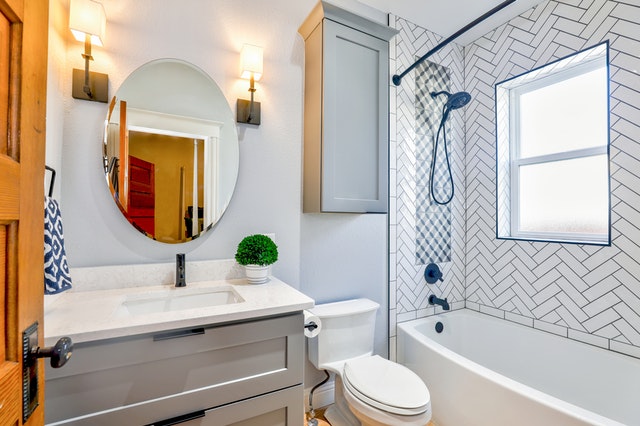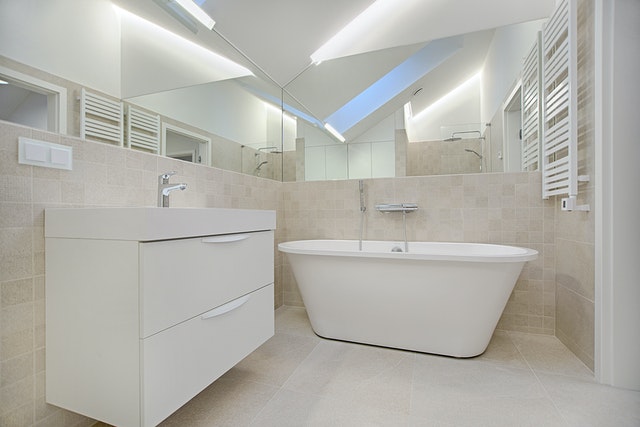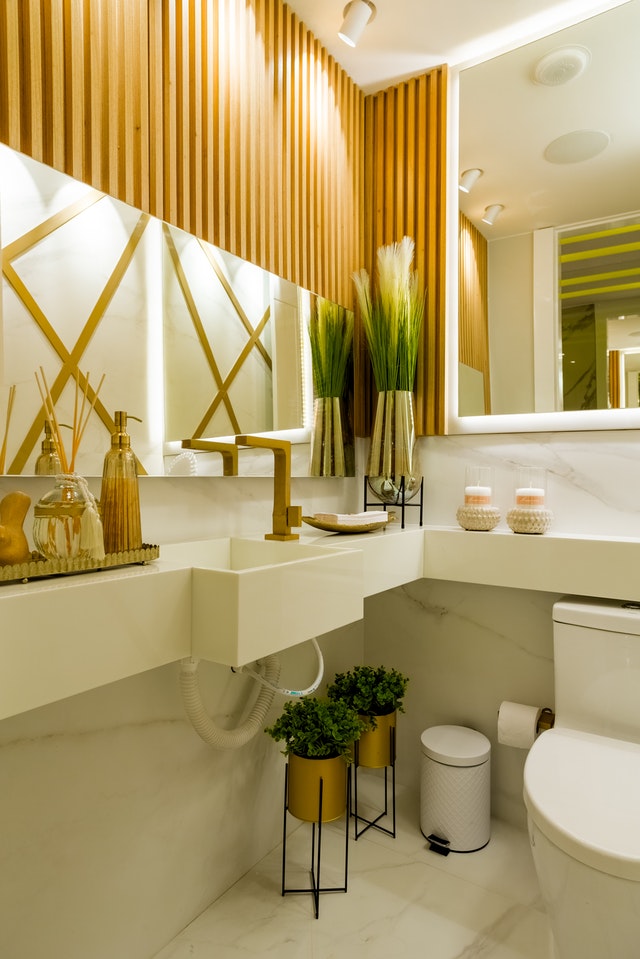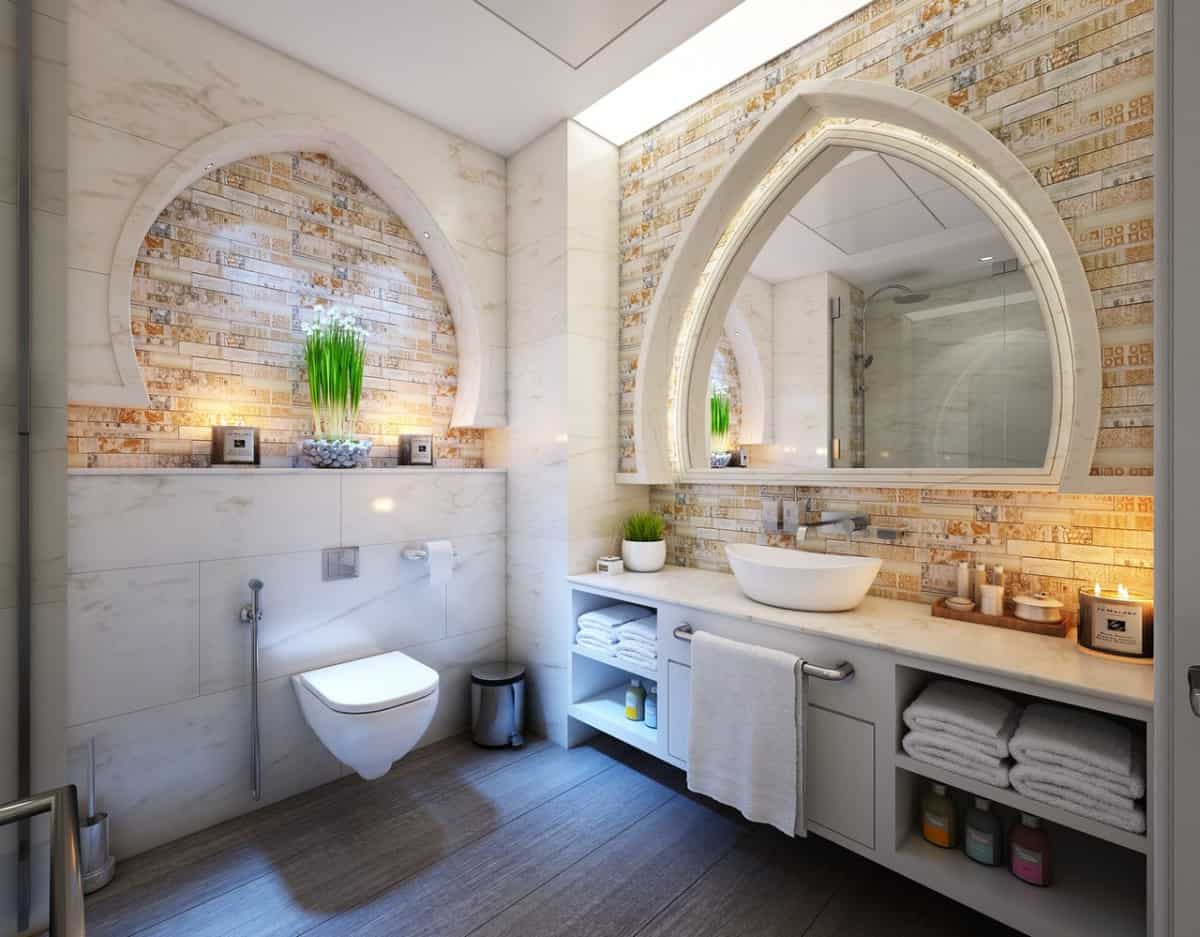This article will show you how many lumens a bathroom needs. We will also learn the different factors influencing the lumens, such as the task areas, the kinds of lighting fixtures used for specific parts of the bathroom, and the color temperature of the bulbs.
A bathroom should have at least 500-600 lumens in the room and a minimum of 700-800 lumens in the task areas, including the vanity area in the sink and the shower. Task areas needed that amount because we do our makeup, shaving, and other grooming activities in those areas.
There’s more to it than simply stating the brightness rating of the bulbs you need to purchase. Placement of lighting matters greatly as well as the shape of the light source and there’s many more things to take in to account to get the balance just right.
So with that said, keep reading and you’ll learn everything you need to know about lighting for your bathroom and what questions you need to ask when shopping for new lights.
I’ll even throw in a few of my recommendations for excellent bathroom lighting options.
Lumens Have a Lot of Importance

Understanding Lumens and Lighting
Lumens are important in buying the right light fixtures for our houses. The right amount of lumens in a room help make rooms look bigger or brighter depending on the size or state of lighting.
For example, brighter lighting makes small rooms look bigger, and dimmer lighting makes big rooms a bit stuffier because of the lack of light in the room.
Higher Lumens and Lower Wattages are a Perfect Tandem in Light Bulbs.
It is important to remember that lumens measure the light bulb output or the amount of light it gives. Lumens are much more reliable nowadays than wattage when buying lights.
We have to remember that higher lumens/lower wattages are the best combinations of lights. For example, an old-style, traditional incandescent bulb gives out 500 lumens while using 40W for power. It is generally known that incandescent bulbs use a lot of wattage for lower lumens.
To put things into perspective, a standard incandescent bulb with 800 lumens consumes 60 watts. Incandescent lights are notoriously known for being too expensive to use.
A 100W incandescent bulb might cost a household approximately $131.40 a month. On the other hand, modern LED lights give out 500 lumens for only five to eight watts consumed for power.
Translating it to dollars, five to eight watts costs around $10.50, which is nine percent of the total usage for the incandescent lights of the same lumens. In other words, lower wattage in a light bulb means lower energy consumption while getting the most out of the lights we buy.
Three Factors Affecting the Lumens in the Bathroom

Bathroom Lightings Have Different Uses.
Generally, bathrooms use dry-rated lighting. Dry-rated lighting means lighting fixtures that are meant to be used on places without moisture or water reaching the bulbs.
Ceiling lights are enough for ambient lighting, but not so much for grooming and makeup. It can cause shadows or uneven lighting when doing makeup, flossing, or shaving.
Task lighting comes into play here since the mirror is the focal point here. In a standard medium sized bathroom, there should be at least three or four vanity lights above the mirror, placed 75 to 80” from the floor and wall sconces on both sides of the mirror, which are placed 66” from the floor, so that the lighting gets evenly spread out in all directions.
Showers and Bathtubs Usually Require Wet-Rated lighting.pic
Meanwhile, wet-rated lighting is recommended to use in the shower area. Wet-rated lighting can resist splashing water, so it is considered safer than dry-rated lighting used in the ceiling light.
In this case, using shower trim recessed light is perfect for shower area lighting.
As we all know, water is a conductor so wet-rated lighting means fewer accidents. We can also use damp-rated lighting for bathtubs. These kinds of lighting handle moisture and condensation for safety purposes as well.
Bathroom Lighting Should be Bright Enough Just Like the Daylight.
It is important to remember that bathroom lighting should at least be 500 to 600 lumens to mimic the daylight. The task areas should have 700 to 800 lumens, because they are placed in vanity areas where we do our makeup, shaving, flossing, and other activities, where more adequate lighting is required.
Lighting should mimic the daylight in line with our circadian rhythms. Also, take note that clothes and makeup look better in daylight.
Considering the Color Temperature is Very Important.
Mimicking the daylight doesn’t mean that all daylights look alike. Daylights differ according to the seasons. Daylights in winter are different from daylights in spring or summer. Winter daylights are bluer in color, or about 6500K. CRI means color rendering index.
The color rendering index measures how a light source renders color when compared to a full spectrum source of the same color temperature in real life.
Going back, choosing a low CRI for the bathroom might make tasks such as putting on makeup more difficult since it makes colors unnatural to look at.
On the other hand, having a higher CRI in lighting can also make seeing colors more difficult as it gives a blue or amber cast on objects. It can also affect the overall look of the room unintentionally, making the mood more somber or melancholic.
Mimicking Daylight in the Bathroom is Very Important

Seeing Daylight Helps with the Human Body Clock.
The circadian rhythm is a natural process that regulates the sleep-wake cycle. It uses light-dark signals to predict what to do in the future, such as the moments you wake up and sleep.
Seeing the daylight wakes your body up naturally, just like the natural sunshine. It will also help you fall asleep earlier in the evening since bright morning light shifts the sleep time earlier.
You will feel sleepy earlier in the evening and wake up earlier in the morning. Naturally, you will also wake up refreshed and it also brightens your mood in general.
Bathroom Lighting Should Mimic Natural Lighting or Daylight.
It is worth remembering that setting similar lighting in the bathroom helps not disrupt the circadian rhythms. Lights that are too harsh might wake you up prematurely, making it hard for you to go back to sleep, for example when you have to go to the bathroom to pee at three in the morning.
Lighting also affects the release of melatonin in humans. Melatonins are hormones released by the body to regulate the sleep-wake cycle. Melatonins and the circadian rhythms work hand in hand to regulate your body to rest or wake up.
Dimmers are Very Important in Bathroom Lighting.
As mentioned earlier, vanity lights need bright enough lighting for makeup and grooming purposes.
Having too bright lights might disturb the body’s circadian rhythms especially when you have to wake up in the middle of the night just to drink water or do your personal business in the bathroom.
Installing dimmers can help fix this problem when incorporated in the bathroom lighting. It also adds ambiance and saves more energy.
LED Lights are the Best Option for Bathroom Lighting.
Traditionally, incandescent lighting is used in bathrooms. However, today, it is banned in the US due to the tungsten inside the incandescent light bulbs causing health issues to its users. Meanwhile, LED lights use less watts while bringing more lumens. LEDs use six to eight watts for brighter lumens.
It also lasts longer, with some lights reaching the maximum of 50,000 hours. LED lights are more durable because they have diodes inside and do not use a lot of wattage, so there is no need to worry about filaments breaking or mercury leaking out of the bulbs when it falls on the floor by accident.
Lastly, LED lights do not get too hot because they do not use too much energy, unlike incandescent lights or compact fluorescent lights (CFLs).
You can buy LED lights at your nearest hardware, supermarkets, or online. In Amazon, you can find LED lights priced for as low as $11, but you can also buy a set of 24 LED light bulbs for only $22, making each bulb cost $0.93 individually.
Of course, it’s important to buy light bulbs that are not only cheaper but also long-lasting and safe to use, since we are going to use it in the bathroom.
Conclusion
Bathrooms should have bright enough lighting but it is important to put focus on the task areas, such as the vanity area in the sink.
Several factors such as the color temperature, the types of lighting fixtures in certain areas, and the type of lighting should be taken into consideration as when installing lighting in your bathroom.
Lastly, bathroom lighting should mimic the brightness and warmth of the daylight because lighting affects the circadian rhythms of our body, which in turn affects our body and our performance for the rest of the day.
P.S.
That’s it for this article. I hope you enjoyed reading it and if you think it might be useful for someone else then please share it on social media, email or your own website! It really encourages us to write more content and grow the site!
If you’re interested in reading more about smart light, smart garages and smart homes checkout some of the other houshia categories including:

